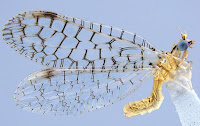Sisyrid Lacewings, Sisyridae, are a small group of Neuropteran Insects today, with about 70 living species in four genera, mostly living in tropical areas. Based upon their relationships to other Neuropterans, Sisyrids are thought likely to be an ancient group, but they have only a limited fossil record, with six described fossil species, all from Eurasia. The oldest of these fossil species, Paradoxosisyra groehni, comes from Middle-to-Late Cretaceous Burmese Amber, from Kachin State in Myanmar, and is considered to be sufficiently different from all other known Sisyrids, living and fossil, to place it in a separate subfamily, the Paradoxosisyrinae.
In a paper published in the journal ZooKeys on 23 February 2018, Qiang Yang of the State Key Laboratory of Biocontrol at Sun Yat-sen University, the College of Life Sciences at Capital Normal University, and the Geoscience Museum at Hebei GEO University, Chaofan Shi, also of the College of Life Sciences at Capital Normal University, and the School of Earth Sciences and Engineering at Sun Yat-sen University, Dong Ren and Yongjie Wang, again of the College of Life Sciences at Capital Normal University, and Hong Pang, also of the State Key Laboratory of Biocontrol at Sun Yat-sen University, describe a second species of Sisyrid from Cretaceous Burmese Amber.
Cretaceous ‘Burmese Amber’ has been extensively worked at several sites across northern Myanmar (though mostly in Kachin State) in the last 20 years. The amber is fairly clear, and often found in large chunks, providing an exceptional window into the Middle Cretaceous Insect fauna. This amber is thought to have started out as the resin of a Coniferous Tree, possibly a Cypress or an Araucaria, growing in a moist tropical forest. This amber has been dated to between 105 and 95 million years old, based upon pollen inclusions, and to about 98.8 million years by uranium/lead dating of ash inclusions in the amber.
The new species is named Stictosisyra pennyi, where ‘Stictosisyra’ means ‘speckled Sisyrid’ in reference to a pattern of markings on its forewing, and ‘pennyi’ honours the late Norman Penny for his work on Lacewings and is kindness to Qiang Yang and Chaofan Shi during a visit to the California Academy of Sciences in 2016. The species is named from a single male specimen 2.9 mm in length. This specimen lacks the highly specialized mouthparts seen in Paradoxosisyra groehni, but is nevertheless thought to be more closely related to that species than to any other Sisyrid, living or fossil, and is therefore placed in the Paradoxosisyrinae.
Stictosisyra pennyi, male specimen, (A) photograph and (B) drawing. Scale bars are 1 mm. Yang et al. (2018).
See also...
Follow Sciency Thoughts on Facebook.











